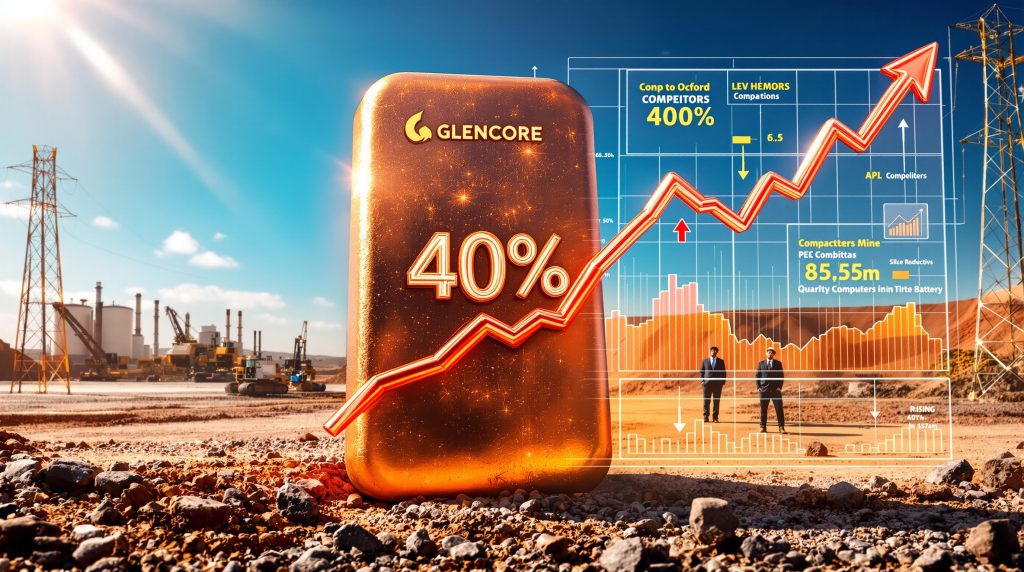Glencore's Copper Challenges: Why Production Declines Threaten Market Position
Glencore, once considered among the most formidable players in global mining, faces mounting pressure as its copper production challenges continue to decline for the fourth consecutive year. This persistent downward trend has raised serious concerns among institutional investors, with many questioning the company's operational capabilities and strategic direction in the copper sector.
The production shortfalls come at a particularly inopportune moment, as copper price outlook remains robust and competitors aggressively expand their output to capitalize on growing demand. This divergence between market opportunity and operational reality has contributed to Glencore's 30% share price decline over the past three years, significantly underperforming industry peers.
Despite these challenges, the company has seen a recent 17% share price increase in September 2025, primarily driven by rising copper prices following supply disruptions at a major Freeport-McMoRan mine in Indonesia. However, this market-driven recovery hasn't alleviated fundamental concerns about the company's operational execution.
Why Investors Are Concerned
George Cheveley, portfolio manager at Ninety One (a Glencore shareholder), expressed the growing frustration: "There has been a frustration amongst investors, particularly on the operational side. Something needs to change in terms of the way they run the company." This sentiment has been echoed by multiple top-35 shareholders who have privately voiced disappointment with the company's performance.
Beyond falling production numbers, Glencore hasn't reported a net profit since the first half of 2023, adding financial pressure to an already challenging operational situation. The company's inability to capitalize on favorable copper market conditions has particularly concerned investors focused on long-term copper investment insights.
How Severe is Glencore's Copper Production Decline?
Production Trajectory and Current Status
Glencore's copper output has been on a consistent downward trajectory, with 2025 production expected to be approximately 40% lower than 2018 levels. The first half of 2025 was particularly problematic, with production falling so dramatically that the company would need to increase output by roughly 50% in the second half to meet its annual targets.
This decline stands in stark contrast to the broader industry trend, where major competitors are expanding copper production to meet growing demand from renewable energy technologies and electric vehicle manufacturing. Even if Glencore meets its current guidance, 2025 production would still be approximately 19% below the company's own predictions made in its 2022 three-year forecasts.
Key Production Metrics Showing the Decline
| Year | Annual Copper Production | % Change from Previous Year | % of 2018 Production |
|---|---|---|---|
| 2018 | Base Year | – | 100% |
| 2022 | Declining | Negative | ~80% |
| 2023 | Declining | Negative | ~70% |
| 2024 | Declining | Negative | ~65% |
| 2025 | Projected Decline | Negative | ~60% (if targets met) |
Market analysts remain skeptical about Glencore's ability to achieve even these reduced production targets. According to Ben Davis, an analyst at RBC Capital Markets, "The second half is hugely important. Expectations are at rock bottom — even if they hit the bottom of guidance, they are going to exceed expectations." This sentiment reflects how significantly investor confidence has eroded regarding Glencore's operational capabilities.
What Factors Are Driving Glencore's Copper Production Challenges?
Operational Inefficiencies Across Mining Assets
Glencore's production challenges stem from multiple operational issues across its global copper portfolio. These include:
-
Declining ore grades: Several major mines are yielding lower copper content per ton of processed ore, reducing output efficiency.
-
Processing bottlenecks: Equipment failures and inefficient recovery rates at processing facilities have hampered production capacity.
-
Weather-related disruptions: Heavy rainfall affecting South American operations has caused unexpected production delays.
-
Extended maintenance periods: Particularly at the Collahuasi mine in Chile, maintenance has taken longer than scheduled.
-
Technical management issues: Potential systemic problems in ore modeling and operational planning have affected production forecasts.
Additionally, Glencore has sold some of its more troublesome mines, which has further contributed to the overall production decline. However, this divestment strategy hasn't translated into improved operational performance across remaining assets.
Strategic Missteps and Market Positioning
Beyond operational challenges, Glencore appears to be struggling with broader strategic issues:
-
Asset portfolio decisions: Selling some troubled mines has further reduced production capacity without adequately strengthening remaining operations.
-
Glencore smelter challenges: Cost control issues at facilities like Horne and Asturiana smelters have reached critical levels, with internal assessments suggesting some operations may need to be shuttered. CFO Gavin Heale warned that costs at these facilities "look to be out of control."
-
Inconsistent growth strategy: Multiple abandoned strategic initiatives have created the impression of a company without clear direction:
- Failed merger attempts with Teck Resources and Rio Tinto
- Reversed plans to spin off coal business
- Abandoned consideration of moving primary listing to New York
The company has also held talks about selling a controlling stake in its biggest African copper mine, Kamoto, which has been dogged by operational setbacks. These shifting strategic positions have frustrated investors looking for a coherent long-term vision.
How Have Investors Responded to Glencore's Copper Challenges?
Shareholder Frustration and Market Reaction
The persistent production issues and strategic uncertainty have triggered growing frustration among Glencore's institutional investors. Bloomberg interviewed investment managers at eight top-35 shareholders, most requesting anonymity, who expressed disappointment with the company's performance.
Key investor concerns include:
-
Operational execution: Consistent failure to meet production targets has eroded confidence in management capabilities.
-
Strategic vision: Lack of a clear path forward that doesn't rely on commodity price recovery. Several investors noted the company appears to lack a convincing strategy beyond waiting for prices to improve.
-
Management effectiveness: Questions about leadership's ability to address fundamental issues in both mining operations and trading businesses.
This frustration has manifested in Glencore's share performance, with the stock down 30% over three years despite paying regular dividends and implementing share buyback programs, including a new $1 billion buyback announced in July 2025.
Analyst Perspectives on Recovery Potential
Market analysts have set extremely low expectations for Glencore's copper business, with most projecting the company will miss its own production guidance for 2025. This creates a potential opportunity where even meeting the lower end of guidance could exceed market expectations and potentially drive share price recovery.
Analysts note that Glencore's two largest shareholders—former CEO Ivan Glasenberg and Qatar's sovereign wealth fund—together hold approximately 19% of the company. According to people familiar with the matter, Glasenberg remains supportive of the company's strategy and management, potentially providing some stability amid investor concerns.
What is Glencore's Plan to Address Copper Production Issues?
Announced Recovery Initiatives
Glencore has outlined several initiatives aimed at reversing its copper production decline:
-
Production recovery target: Return to 1 million tons of annual copper production by 2028 through improvements to existing mines.
-
Cost reduction program: $1 billion in planned cost cuts across operations to improve profitability and operational efficiency.
-
Argentina expansion: Filed applications for $13 billion in new copper projects in Argentina, representing a major strategic bet on new production sources.
-
Trading profit goals: Increased trading profit targets for the first time since 2017, leveraging the company's traditional strength in commodities marketing.
-
Capital markets day: Scheduled for December 2025, the first in three years, to communicate strategy and copper growth prospects to investors.
These initiatives represent an attempt to reassure investors that the company has a credible path to recovery, though market skepticism remains high given the company's track record of missed targets.
Potential Strategic Alternatives
Beyond these announced initiatives, Glencore appears to be considering more dramatic strategic moves:
-
Major asset sales: Discussions about selling controlling stakes in some African copper operations, particularly the Kamoto mine.
-
Merger possibilities: Continued interest in potential combinations with larger rivals like Rio Tinto. CEO Gary Nagle has reportedly described a Rio-Glencore tie-up as "the most obvious deal in the industry" in private conversations.
-
Smelter restructuring: Potential closure or sale of underperforming smelting operations, particularly in the zinc business where profitability concerns are most acute.
However, with Glencore's share price weaker relative to Rio Tinto now than it was in January 2025 when initial merger talks occurred, such strategic alternatives face significant valuation challenges.
How Does Glencore's Situation Compare to Industry Peers?
Competitive Landscape Analysis
Glencore's struggles stand in sharp contrast to the broader industry landscape, where copper-focused miners are generally thriving. Key competitive developments include:
-
Anglo American-Teck merger: Creation of a new copper mining champion through Anglo's acquisition of Teck Resources, leaving Glencore on the sidelines of industry consolidation.
-
Expansion focus: Major competitors prioritizing copper growth projects to capitalize on strong demand forecasts for the metal.
-
Production growth: Industry-wide push to increase copper output to meet rising demand from renewable energy, electric vehicles, and other green technology applications.
These competitive moves have highlighted Glencore's relative underperformance and raised questions about the company's ability to maintain its market position in the copper sector over the long term.
Operational Challenges Across the Industry
While Glencore's problems appear more severe, it's worth noting that other miners have also faced challenges in expanding copper production:
-
Ivanhoe Mines: Operational challenges at new copper projects have delayed production ramps.
-
Teck Resources: Technical difficulties at major development projects have increased costs and extended timelines.
-
Industry-wide: Rising costs and declining ore grades affecting multiple producers, suggesting some of Glencore's challenges reflect broader sector trends.
These industry-wide difficulties provide some context for Glencore's struggles, though they don't fully explain the company's persistent underperformance relative to peers.
What Are the Implications for Copper Market Supply?
Supply-Demand Dynamics
Glencore's production challenges contribute to broader concerns about copper supply adequacy:
-
Growing demand: Increasing copper requirements for renewable energy and electrification are expected to drive substantial demand growth over the coming decade.
-
Supply constraints: Production difficulties at multiple major mines, including Glencore's portfolio and recent disruptions at Freeport-McMoRan's Indonesian operations, have limited supply growth.
-
Price implications: Potential support for higher copper prices due to supply limitations, with copper currently trading at $4.88/lb with a 2.50% daily increase as of September 2025.
These dynamics create a challenging situation for Glencore—higher copper prices benefit its existing production, but the company's inability to increase output limits its ability to fully capitalize on favorable market conditions.
Market Forecasts and Price Projections
The combination of Glencore's production issues and similar challenges across the industry has led some analysts to project significant copper price increases in coming years. Bank of America analysts have forecasted copper prices to surge past $11,000 per ton in 2026, citing ongoing setbacks at some of the world's largest mines.
This bullish price outlook could provide a lifeline for Glencore if the company can stabilize production and develop its Argentina projects. However, it also represents a missed opportunity if production continues to decline while prices rise, potentially impacting the global copper supply forecast.
What Has Changed in Glencore's Corporate Culture?
Leadership Transitions and Organizational Shifts
Glencore's current challenges coincide with significant changes in the company's leadership and culture:
-
Executive turnover: Retirement of former CEO Ivan Glasenberg and his key lieutenants has removed much of the leadership team that built Glencore into a dominant force in commodities.
-
Trading talent exodus: Senior traders departing for rivals or retiring, including:
- Jason Kluk (head of nickel and ferroalloy trading) left in November 2024
- Sam Imfeld (aluminum and alumina trader) joined Vitol Group in 2025
- Ruan van Schalkwyk (coal-trading head) is retiring
-
Cultural evolution: Shift away from the aggressive, deal-making culture that defined the company's early years as a public entity, described by Bloomberg as a loss of "swashbuckling brashness."
These departures represent a significant loss of institutional knowledge and trading expertise, particularly as some traders have joined competing firms like Vitol Group that are expanding their metals trading operations.
Impact on Operational Excellence
These cultural and leadership changes appear to be affecting Glencore's operational performance:
-
Declining trading prowess: Weaker performance in traditionally strong trading businesses, with the first half of 2025 including one of the worst performances from the energy and coal trading unit on record.
-
Operational management challenges: Difficulties maintaining production excellence across mining assets as experienced leaders depart.
-
Strategic uncertainty: Less clear direction compared to the company's earlier years under Glasenberg's leadership.
As Ben Davis of RBC Capital Markets noted: "When they arrived on the scene everyone considered them the masters of the universe. Yet that short-term market knowledge has not necessarily meant long-term returns. They have not always been proved right." This assessment reflects the growing perception that Glencore has lost some of its competitive edge.
What Are Glencore's Prospects for Copper Recovery?
Near-Term Outlook
Glencore faces significant challenges in the near term:
-
Production target credibility: Market skepticism about meeting current guidance, with the second half of 2025 representing a critical test of operational capabilities.
-
Operational improvements: Need to demonstrate sustainable production enhancements across existing assets to rebuild investor confidence.
-
Strategic clarity: Requirement for more coherent strategic direction, with the upcoming December 2025 capital markets day representing an important opportunity to articulate a convincing vision.
The most immediate focus will be on whether the company can achieve the approximately 50% increase in copper production required in the second half of 2025 to meet annual guidance. Success could provide momentum for a broader recovery in investor sentiment.
Long-Term Potential
Despite current difficulties, Glencore retains several advantages that could support eventual recovery:
-
Resource base: Substantial copper reserves and resources providing foundation for potential production growth.
-
Trading capabilities: Despite recent challenges, the company maintains industry-leading marketing and trading infrastructure that can generate profits independently of mining operations.
-
Financial flexibility: Continuing cash generation from coal and other businesses, allowing for regular dividends and share buybacks despite operational challenges.
-
Argentina potential: Significant growth opportunities if new projects advance successfully, potentially returning the company to 1 million tons of annual copper production by 2028.
The company has also demonstrated resilience in previous downturns, most notably during the 2015 commodity crisis when it was forced to suspend dividends and issue equity, only to see its share price surge 300% over the subsequent two years as market conditions improved.
Can Glencore Regain Its Copper Market Position?
Glencore's copper production challenges represent a critical test for the company's management and strategy. While the immediate outlook remains challenging, with production continuing to decline and investor confidence weakening, the company does have pathways to potential recovery.
Success will likely depend on several factors:
-
Operational execution: Demonstrating ability to meet production targets after years of shortfalls will be essential to rebuilding credibility with investors.
-
Strategic focus: Clearly articulating and implementing a coherent copper growth strategy at the December 2025 capital markets day could help restore market confidence.
-
Project development: Successfully advancing Argentina copper projects to offset production declines at existing operations is critical to long-term growth.
-
Competitive positioning: Effectively responding to industry consolidation and competition, potentially through strategic partnerships or targeted acquisitions.
For investors, the key question is whether Glencore's current struggles represent a temporary setback or a more fundamental deterioration in the company's competitive position in the copper market. The answer will likely become clearer in coming quarters as the company either demonstrates production recovery or continues to fall short of expectations.
The recent 17% share price increase in September 2025, driven by rising copper prices, suggests investors haven't completely lost faith in Glencore's recovery potential. However, sustainable share price appreciation will require more than favorable market conditions—it will demand concrete evidence that the company can reverse its four-year copper production decline and execute effectively on its copper investment strategies.
Potential Catalysts for Recovery
Several developments could potentially accelerate Glencore's recovery in the copper sector:
-
Production outperformance: Exceeding second-half 2025 production guidance would significantly boost investor confidence.
-
Argentina project advancement: Concrete progress on developing the $13 billion copper project pipeline in Argentina would strengthen growth prospects.
-
Strategic transactions: Successful execution of targeted acquisitions or partnerships that enhance the company's copper portfolio.
-
Leadership additions: Recruiting experienced operational talent to strengthen mining execution capabilities.
Whether Glencore can capitalize on these opportunities remains to be seen, but the combination of favorable copper market fundamentals and the company's resource base provides a foundation for potential recovery if operational execution improves.
Ready to Capitalise on the Next Copper Market Opportunity?
Discover the companies positioned to benefit from supply constraints in the copper market with Discovery Alert's proprietary Discovery IQ model, which provides real-time notifications on significant ASX mineral discoveries before the broader market reacts. Visit https://discoveryalert.com.au/discoveries/ to explore how historic mineral discoveries have generated substantial returns for early investors.




